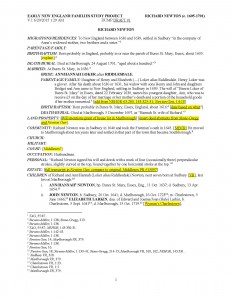 [Editor’s Note: Between June and August of this year, Alicia wrote two series on her research and writing methodologies. In the interest of bringing them together, and sharing them with a fresh audience, they are offered again, with some of the author’s commentary.]
[Editor’s Note: Between June and August of this year, Alicia wrote two series on her research and writing methodologies. In the interest of bringing them together, and sharing them with a fresh audience, they are offered again, with some of the author’s commentary.]
From Collecting published accounts:
This may turn out like watching sausage being made or paint dry, but let’s walk through the process of creating an Early New England Families Study Project entry.
We start with the entry from Torrey’s New England Marriages Prior to 1700:
NEWTON, Richard (–1701) & Anne/Hannah? [LOKER/RIDDLESDALE] (ca 1616–1697); by 1641; Sudbury {Stevens-Miller 132, 138, 143; Marston-Weaver 47; Warner-Harrington 414, 471; Reg. 49:341; Bullard Anc. 153; Chaffee (1911) 134; Holman Ms: Loker 3; Moore Anc. 399; Framingham Hist. 340, 342?; Marlboro Hist. 421; Bent Anc. 27; Newton (#4) 17-18; Bigelow-Howe 94; Leonard (#2) 49; Cutler 2:5; Morris-Flynt 56; Tingley-Meyers 92}
My first step is to locate as many of these sources as possible and begin a comparative analysis of what has already been published. I use the 2011 edition of Torrey’s Marriages, which gives the bibliography or Source List in Volume 3, pages 1739–1830.
From Collecting published accounts: Part Two:
I continue to look up the other citations listed for Richard Newton and generally find that they are rehashes from the Newton Genealogy or older, less complete treatments. A few are “mystery meat,” where page numbers are incorrect and I am unable to locate the exact reference (a common occurrence given that Torrey’s notes are often in pencil and always cramped and difficult to read). A couple of manuscripts are listed (“Warner-Harrington” and “Holman Ms: Loker”) that are only available at the library in Boston. Should I decide I want to see them, I will request copies from my colleague Chris at the library.

From Dump draft:
As I collect enough sources, I will begin a “Dump Draft.” (The accompanying illustration shows a partially completed first Dump Draft for Richard Newton.) The goal of the Dump Draft is to get the information on paper in the Early New England Families Study Project format. This allows me to see exactly what I have and what I need. I add and highlight all kinds of notes and questions to myself.
From Collecting published accounts: Part Four:
The next large group of records that I want to check is the published Massachusetts Bay Colony records (MBCR). I have downloaded the entire set on my computer and am creating my own hard copy as I work on each sketch. This takes paper and ink, but it eliminates having to find a place to keep the huge large-volume set in the house or to repeatedly pull up the digital version if I already have a page printed. I am collecting similar copies of other published sources (or at least of their indexes) that have a high density of the names I need.
From Collecting published accounts: Part Five:
In our example with Richard Newton, the vital records search is pretty straight-forward. I need to look at the vital records of Marlborough, Southborough, Sudbury, Charlestown, Marshfield, Watertown, Concord, and Framingham, all of which are available on americanancestors.org. I will bring up every birth, marriage, and death from the database, record the volume and page citations, print every relevant page for proofreading later (and to avoid Murphy’s Law – the one I don’t print will be the one I will have to look up again to settle a question or discrepancy). Then I will compare these to other transcriptions (e.g., early Sudbury records were published in the Register in 1852). Every single one of them, as many versions as I find.
Assuming that I have now gone through all of the relevant published sources within my reach (see my posts on “Cheat Sheets”), the “fun” part, alas, is over. Next, the drudgery begins – composition, analysis, and proofreading.
Continued here.
I eagerly look forward to the completion of your project as Richard is my ancestor and it will save me some research…
Carol, Richard Newton’s sketch has just been posted to the Early New England Families database on the website.
Nice Job!
Thank you.
I have this set aside to refer to so I can keep in mind the approach you use as I approach the stage of deep research and analysis! Thanks, Alicia.
Annie, Happy researching and analyzing!
What a terrific series on your research process. I am so inspired that I am writing a sketch using the project format and your process on my New England ancestor who is likely on your project “to do” list given his inclusion in Torrey’s marriages. Since I already have a significant amount of documentation, it will be not as daunting a task and thoroughly satisfying to accomplish. Perhaps when I complete it, your team might find it useful.
Carole, Good for you. You’ll find it is more fun than it seems!
Is it not true, as has been claimed, that Richard Newton is the uncle of Sir Isaac Newton? (He is my ancestor also).
Patricia, not that we know of since we do not know who Richard Newton’s parents were. One of those tales people like to make up to connect to interesting history, I’m afraid.